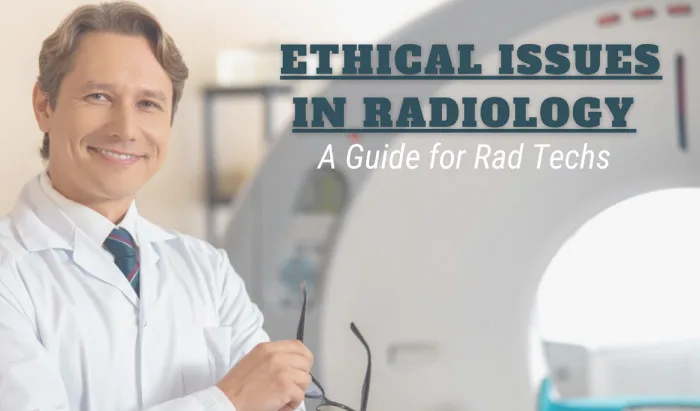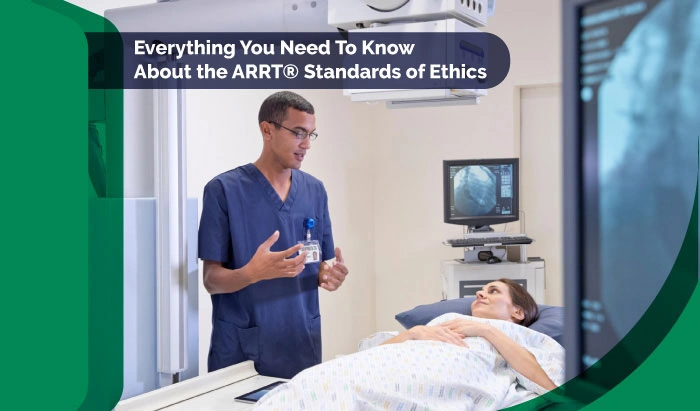Ethical Issues in Radiology: A Guide for Rad Techs

Ethical Issues in Radiology Medical Imaging: A Guide for Rad Techs on Ethics in Radiology


Radiologic technologists plays a key role in the healthcare cycle. Acting with compassion and sensitivity, as well as with professional behavior, all while remaining calm is an integral part of this role. Remembering that patients and their families are your first priority, as well as maintaining a high regard for all fellow employees is your duty. You must adhere to a professional ethical code composed of efforts and behaviors that society holds as valuable and worthy. In this article, we’ll look at ethics and ethical issues in the radiology department, specifically as they apply to medical imaging professionals. We’ll cover at ethics in relationship to patient care and to your colleagues, and we’ll pose a few ethical dilemma scenarios for your consideration.
- Why is there a need for radiologic technologists to study ethical issues in medical imaging?
- Systems of Ethics, Law, and Morals in Radiology
- Ethics in the Radiology Medical Imaging Profession
- Patient Rights, Protections, and Consent as Part of Ethical Decision-Making
- Relationships with Physicians and Other Healthcare Professionals
- Ethical and Moral Dilemmas
- Identifying Moral and Ethical Dilemmas
- Summary
- References
Why is there a need for radiologic technologists to study ethical issues in medical imaging?
Professional ethics is one of several generally accepted criteria that serve to distinguish a profession from other occupations or trades. It is a written code that does not apply to any specific situation. During your career, you will encounter disturbing situations which may involve basic human rights, such as the right to privacy and the right to be told the truth. As a radiologic technologist, you must balance these rights with the obligation to adhere to physicians’ orders and administrative policies, and knowing the right thing to do, may not always be easy—this is where ethics comes in.
Ethics deals with the “rightness and wrongness” of an act or behavior as compared with natural reason. Professional behavior is defined by professional Standards of Conduct and Scopes of Practice. Ethical attitudes come from sources such as science, culture, religions, and experiences.
Systems of Ethics, Law, and Morals in Radiology
Laws are regulations established by governments, be they federal, state, or local. Societal behavior is defined by laws, rules, regulations, and ordinances. Laws can be limiting and are not comprehensive in controlling all behaviors. Laws require enforcement and the authority. They can be politically motivated and applied unequally.
Laws exist so that the rights of an individual or group cannot be encroached on by another individual or group. Laws remain dynamic when appropriate to reflect the dynamic nature of societies. They must be applied equally to all without discrimination. The three types of law are constitutional law, legislative law, and case law. Constitutional law is the supreme law of the land and is separated into three branches, the executive, the legislative, and the judiciary. Case law is a law that is based on a case-by-case basis and can set a future precedent. And legislative law contains administrative rules, regulations, and ordinances. Many areas of health care are defined by these regulations.
Morals are accepted customs of living by right and proper conduct and an individual’s practice in relation to these customs.
Ethics in the Radiology Medical Imaging Profession
Society expects a profession, through its collective members, to generate its own statement of acceptable and unacceptable behaviors. For radiologic technologists, the ethical and professional standards of our profession, or the established norms for our conduct, are defined by two distinct documents: The American Registry of Radiologic Technologists (ARRT)® Standard of Ethics, parts A and part B.
Part A of the Standard of Ethics is known as the Code of Ethics. These are the eleven aspirational principles that should guide us. All medical imaging professionals should be familiar with these principles. Ethical codes are typically static and slow to change to reflect changing societal trends and values. They rely heavily on behaviors that reflect professional etiquette and are respectful of human values.
Part B is the Rules of Ethics, and contains the mandatory rules of professional conduct for radiologic technologists. They are mandatory standards of minimally acceptable professional conduct for all ARRT® Certificate Holders and Candidates. Certification and registration are methods of assuring the medical community and the public that an individual is qualified to practice within the profession. Because the public relies on certificates and registrations issued by the ARRT® organization, it is essential that Certificate Holders and Candidates act consistently with these Rules of Ethics in radiology. These Rules of Ethics are intended to promote the protection, safety, and comfort of patients.
Takeaway: The ARRT Standard of Ethics contains two parts, the Code of Ethics, and the Rules of Ethics. Both play a vital role for radiologic science professionals.
To learn more about the ARRT® Standards of Ethics, questions you’ll be asked during certification and recertification, and how and when to report ethical violations, check out our complete guide: Everything You Need to Know About the ARRT® Standards of Ethics.
Patient Rights, Protections, and Consent as Part of Ethical Decision-Making
Being aware of the rights and protections a patient has is a critical component of identifying ethical issues and of ethical decision-making in medical imaging the radiology department, as it is in all of healthcare. In this section, we’ll address patient rights and the ways in which patients may feel wronged or mistreated while undergoing medical procedures.
Patient Rights
The American Hospital Association (AHA) recognizes the importance of a patient’s rights and has published these in a document called “A Patient’s Bill of Rights.” The AHA’s Patient’s Bill of Rights includes a set of fifteen guarantees for anyone who seeks medical care in a U.S. hospital. They promote respect for patients and providers, open dialog about diagnosis, treatment, and fees, and the delivery of effective patient care.
The relationship between patients and health care practitioners was defined in 1914 by a precedent-setting case, Schloendorf v. Society of New York Hospital. This doctrine reads “Every human being of adult years and sound mind has a right to determine what shall be done with his own body, and a surgeon who performs an operation without his patient’s consent commits an assault, for which he is liable in damages.”
Malpractice
Injurious or unprofessional treatment of a patient, including neglectful actions, is the definition of malpractice. The four components of malpractice are a duty to the patient, breach of duty or deviation from that duty, causation because of that breach, and finally damage.
Patients can believe they are wronged in other ways. The most common are torts, a patient’s claim that he or she has been wronged or has sustained some injury other than a breach of contract; assault when a patient believed he or she has been threatened in such a way to fear immediate bodily harm, such as the fear from a comment made by a radiographer threatening to repeat a painful image if the patient doesn’t hold still; battery or touching a patient without their permission even if no injury occurs; and false imprisonment, when someone is retrained or believes that they are being restrained against their will.
Informed Consent
Informed consent is another key area that all imaging science professionals should be aware of. For consent to qualify as informed, the patient must understand the procedure completely and have all the information he or she needs to make an autonomous decision. The patient should sign an informed consent form that contains:

- A patient understanding clause to verify the patient understands the procedure
- An authorization clause that permits the examination or procedure to be conducted
- A disclosure clause explaining the procedure, risks, benefits, and alternatives
- An anesthesia clause if anesthesia is to be used
- A no-guarantee clause for therapeutic procedures
- A tissue-disposal clause if tissue will be removed
- And finally, a signature clause for the patient and a witness
Takeaway: Tort, assault, battery, and false imprisonment are ways that patients can feel they are wronged while receiving care or undergoing a medical procedure.
Relationships with Physicians and Other Healthcare Professionals
When healthcare professionals do not communicate effectively, patient safety is put at risk for several reasons: lack of critical information, misinterpretation of information, unclear orders over the telephone, and overlooked changes in status. Lack of communication creates situations in which medical errors can occur. These errors have the potential to cause severe injury or unexpected patient death.
Collaboration in healthcare is defined as healthcare professionals assuming complementary roles and working together cooperatively, sharing responsibility for problem-solving, and making decisions to formulate and execute plans for patient care. Collaboration between radiologic technologists, physicians, nurses, and other healthcare professionals increases team members’ awareness of each other’s specialized knowledge and skill sets, leading to continued improvement in decision-making.
Ethical Issues in Medical Imaging and Moral Dilemmas

All professional decisions in radiologic sciences and other health care practices involve a consideration of human values. Unethical behavior that is clearly wrong can be defined as an ethical outrage. Ethical dilemmas occur when the correct choice is not clear and personal values may conflict. Ethical dilemmas require an ethical analysis. There are many basic ethical theories and principles, but almost all professional codes of ethics in radiology are based on beneficence or “the active doing of good.” The good of an activity is evaluated based on whether immediate harm is balanced with any future benefits. We know this as consequentialism where decisions are based on consequences or outcomes of a specific act.
In medical ethical decision-making, we use moral rules such as the Bible, the Golden Rule, the Ten Commandments, and of course “Do no harm.” Non-maleficence is the principle that places high values on doing no harm. There is also a new school of thought that focuses on the use of practical wisdom for both emotional and intellectual problem-solving.
So how do you avoid ethical conflicts? First, you need to understand that in some situations the conflict is unavoidable. The next step would be to clearly understand the right thing to do and the wrong thing to do, based on the professional ethics for medical imaging professionals in radiology. And finally, try to always choose to do the right thing in your situation.
Takeaway: Beneficence, or “the active doing of good,” is what most professional codes of conduct are based on. Ethical dilemmas occur when the correct choice is not clear and may conflict with personal values.
Identifying Moral and Ethical Issues in Medical Imaging
While it may not always be easy to know the right thing to do in a given situation, radiology technologists can rely on thinking routines and their professional code of ethics in radiology to routinely make a good faith effort to make the correct, ethical choice. Below we’ll review the steps medical imaging professionals can use to problem solve when ethical issues arise in the radiology department and pose three scenarios for your consideration and practice.
Problem Solving Process for Ethical Decision-Making
- Identify the problem
- Develop alternative solutions
- Select the best solution
- Defend your solution (on the basis of the Code of Ethics)
- And finally, recognize your professional limitations
Taking the time to go through each step will help ensure that the correct and ethical decision has been made.
Examples of Ethical Issues in Medical Imaging: Three Scenarios
Let us look at three different ethical issues in medical imaging and their solutions.
- State laws
- Professional ethics in radiology
- Local statutes and ordinancesn
- Federal constitutional laws
Answer and Explanation
- Ethical dilemma
- Ethical violation
- Moral violation
- Virtue
Answer and Explanation
Answer and Explanation
Summary
As we discussed, ethics in rdiology is a combination of societal laws and values. Professional ethics is specific to an occupation and defined by the members of that profession at many levels. Ethical dilemmas naturally occur, and they require a thorough analysis before a decision is made. And finally, ethical medical imaging professionals must possess a keen sense of the role that human values play in resolving ethical issues that arise in professional practice in the radiology department. These can be in dealings with patients and in the interactions with physicians and other healthcare professionals. Radiologic science professionals are legally liable for their actions in the daily performance of procedures and the management of their patients. Professionals must respect patient autonomy and confidentiality must be always kept. All healthcare professionals have a responsibility to understand and practice the Standards of Care for their profession.
References
- Adler, A., & Carlton, R. Introduction to Radiologic Sciences and Patient Care. 5th ed. St Louis, MO: Elsevier Saunders; 2018
- Christensen, C., & Larson, J. R., Jr. (1993). Collaborative medical decision making. Medical Decision Making: An International Journal of the Society for Medical Decision Making, 13(4), 339–346. [Link]
- Ethics Chapter 1 Flashcards | Quizlet, [Link].
- Joint Commission on Accreditation of Healthcare Organizations. The Joint Commission guide to improving staff communication. Oakbrook Terrace, IL: Joint Commission Resources
- Matthews, E. P., & Matthews, T. M. (2015). Medical Ethics and Law in Radiologic Technology. Radiologic Technology, 87(2), 163–184.
- Pozgar, G. (2016). Legal and Ethical Issues for Health Professionals. 4th ed. Burlington, MA: Jones & Bartlett Learning; 1-49, 69-74, 121-234, 245-249, 264, 360-361, 437-465.
Disclaimer: The information provided on this website is intended to provide useful information to radiologic technologists. This information should not replace information provided by state, federal, or professional regulatory and authoritative bodies in the radiological technology industry. While Medical Professionals strives to always provide up-to-date and accurate information, laws, regulations, statutes, rules, and requirements may vary from one state to another and may change. Use of this information is entirely voluntary, and users should always refer to official regulatory bodies before acting on information. Users assume the entire risk as to the results of using the information provided, and in no event shall Medical Professionals be held liable for any direct, consequential, incidental or indirect damages suffered in the course of using the information provided. Medical Professionals hereby disclaims any responsibility for the consequences of any action(s) taken by any user as a result of using the information provided. Users hereby agree not to take action against, or seek to hold, or hold liable, Medical Professionals for the user’s use of the information provided.



